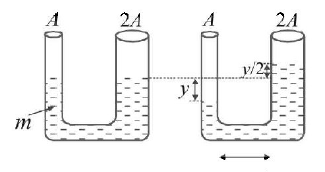Question
A $$U$$-tube is of non uniform cross-section. The area of cross-sections of two sides of tube are $$A$$ and $$2A$$ (see fig.). It contains non-viscous liquid of mass $$m.$$ The liquid is displaced slightly and free to oscillate. Its time period of oscillations is
A $$U$$-tube is of non uniform cross-section. The area of cross-sections of two sides of tube are $$A$$ and $$2A$$ (see fig.). It contains non-viscous liquid of mass $$m.$$ The liquid is displaced slightly and free to oscillate. Its time period of oscillations is

A.
$$T = 2\pi \sqrt {\frac{m}{{3\rho gA}}} $$
B.
$$T = 2\pi \sqrt {\frac{m}{{2\rho gA}}} $$
C.
$$T = 2\pi \sqrt {\frac{m}{{\rho gA}}} $$
D.
None of these
Answer :
$$T = 2\pi \sqrt {\frac{m}{{3\rho gA}}} $$
Solution :
Suppose the liquid in left side limb is displaced slightly by $$y,$$ the liquid in right limb will increase by $$\frac{y}{2}.$$ The restoring force
$$\eqalign{ & F = - PA = - \rho g\left( {\frac{{3y}}{2}} \right) \times 2A = 3\rho gA\left( { - y} \right). \cr & a = \frac{F}{m} = \frac{{3\rho gA\left( { - y} \right)}}{m} \cr} $$

On comparing with, $$a = - {\omega ^2}y,$$ we get
$$\omega = \sqrt {\frac{{3\rho gA}}{m}} \,\,{\text{and}}\,\,T = 2\pi \sqrt {\frac{m}{{3\rho gA}}} $$
Suppose the liquid in left side limb is displaced slightly by $$y,$$ the liquid in right limb will increase by $$\frac{y}{2}.$$ The restoring force
$$\eqalign{ & F = - PA = - \rho g\left( {\frac{{3y}}{2}} \right) \times 2A = 3\rho gA\left( { - y} \right). \cr & a = \frac{F}{m} = \frac{{3\rho gA\left( { - y} \right)}}{m} \cr} $$

On comparing with, $$a = - {\omega ^2}y,$$ we get
$$\omega = \sqrt {\frac{{3\rho gA}}{m}} \,\,{\text{and}}\,\,T = 2\pi \sqrt {\frac{m}{{3\rho gA}}} $$